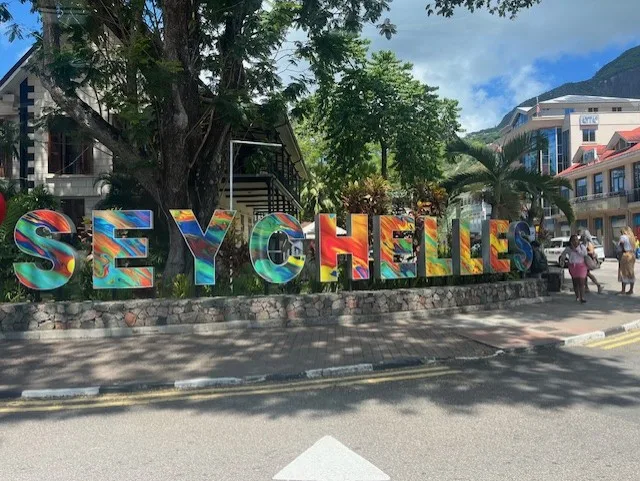
This guest blog is by Avril Joffe, the UNESCO Chair in Cultural Entrepreneurship and Policy, and Research Associate, University of the Witwatersrand. Avril is a member of the Global Creative Economy Council. The opinions are those of the author and do not necessarily represent the views of Creative PEC.
“We are not small island states, we are the custodians of the largest ocean on the planet.”
At the Pacific Island Festival of the Arts in Hawaii in 2024, the ability of the Pacific region to reframe the narrative to centre their traditional knowledge remains imprinted in my memory. It echoed the efforts to change the narrative about Africa.
This reframing is also important in relation to climate change and the role of the culture sector in adaptation, mitigation and awareness raising. With the GCEC’s visit to Indonesia in October 2025 it seems timely to reflect on the relationship between climate change, cultural expressions and island states. This has long been a concern of mine since I started working as a technical advisor on cultural policy and governance to UNESCO in 2011 and took part in informative missions to Seychelles, Mauritius and Jamaica as well as the opportunity, as a member of the UNESCO Expert Facility, to work closely with Antigua and Barbuda and many of the Pacific Islands. While Indonesia is not a small island development state, it is an archipelagic country highly vulnerable to climate change with culture a central pillar in building resilience across many of its islands.
What strikes me about all island states is their reliance on global connectivity (tourism and trade), the urgency of climate changes and most importantly, the limited attention given by public authorities to the creativity and cultural life of the community in adaptation responses or mitigation of the climate emergency.
The climate emergency for island states
Island states face particular climate challenges from decreases in annual rainfall (Mauritius), upward trends in annual temperature (Fiji), rising sea levels (Kiribati), increasing aridity (Seychelles), more chance of drought (Jamaica), tropical storms (Philippines), floods (Bahamas) and many others. While not in the cyclone belt of the Caribbean or Pacific islands such as Dominica or Vanuatu, many Indonesian islands face extreme rainfall events (Java), monsoonal floods (Sumatra), and storm surges (Sulawesi) linked to the Indian Ocean Dipole (IOD) and El Niño/La Niña cycles.
As ‘custodians of the largest ocean on the planet’, Pacific islanders embrace their traditional knowledge systems to mitigate climate change and improve adaptation in the absence of high-tech forecasting. One such traditional knowledge practice is sustainable marine stewardship which adopts tabu (temporary closures of fishing grounds) to facilitate regeneration of fish stocks and reduce overfishing to maintain ocean biodiversity. These reefs and mangroves then act as coastal buffers and carbon sinks to reduce the impact of storms and sea-level rises. Another, which was beautifully showcased at the Festival of Pacific Arts and Culture in Hawaii in 2024, is their navigational knowledge from wayfinding and star navigation to indigenous climate forecasting.
Research focusing specifically on creative practice for flood and drought resilience is limited, although there is a wealth of research on using creative practice in fields of health, environmental issues, and climate change communication. Whether creative practice leads to action improving resilience to droughts and floods in marginalised communities remains a key topic for future research although several short-term benefits of the creative practice approaches are already recognised. These include more understanding of the issues, increased interaction within the community, and less fatalistic, more positive, ideas for adapting to future drought.
Typically, the response to climate challenges including disaster risk management or mitigation responses in island states focus exclusively on the scientific, methodological and technical aspects with insufficient attention given to what constitutes the nexus between peoples and the natural environment, namely their culture and knowledge that throughout time has allowed communities to develop the resilience needed to adapt to a changing natural environment.
How culture can help
Research has shown that culturally responsive participation processes in communities focusing on culture, creativity and cultural expressions contribute to social cohesion and social capital – the sense of belonging and voluntary social participation which is important to the adaptive ability of communities to withstand disaster related trauma and stressors.
Many island states have responded to the climate emergency drawing on cultural heritage, indigenous knowledge systems and cultural expressions. Examples include Seychelles where SNICHA (the Seychelles National Institute of Culture, Heritage and Arts) has a project to support research and documentation of intangible cultural heritage and traditional knowledge systems with a focus on biodiversity conservation, climate change and disaster risk reduction. It builds on the work carried out by UNESCO since 2016 on the safeguarding of intangible cultural heritage in emergency situations as well as the UNESCO Local and Indigenous Knowledge Systems (LINKS) programme. The project considers how to engage with intangible cultural traditions such as the UNESCO inscribed traditional nocturnal dance, Moutya and with traditional story-telling. The Moutya is practiced at social gatherings, national and cultural events and performed spontaneously within the community on pay day at the end of the month to the rhythm of a Moutya drum. It is therefore key to community identity and participation. Traditional storytelling, or the folktale, was brought in by slaves, indentured labourers and settlers during the colonial period and has undergone a creolisation in the plantation islands such as Seychelles due to the wide variety of ethnicities that were thrown together through slavery and the colonial system.
Drawing on cultural heritage, indigenous knowledge and cultural expressions has three key benefits for island states.
Enhancing environmental sustainability
First, enhancing environmental sustainability by acknowledging cultural heritage and respecting indigenous knowledge systems (traditional land and marine resource management).
Renewed interest in Seychellois heritage architectural design of the raised-roof Creole house is now celebrated as part of Seychellois Creole identity and climate smart design. This traditional house design – a timber structure raised on stone or coral foundations to protect from damp and pests with raised steep-pitched roofs with ventilation gaps/ louvred openings at the gable ends allowing a throughflow of fresh air and wide verandas to provide shade – was dominant in late 18th through to the 20th century.
Colonial trade networks (making galvanized corrugated iron sheets widely available) and modernity influences (preference for European style stone or concrete buildings) led Seychellois to abandon these vernacular wooden houses so that today only one or two remain. One of these houses the National Craft Centre in the heritage site Domaine de Vale des Pres on Mahé. The building of traditional homes on stilts in the Solomon Islands and in West Sumatra (Rumah Adat) is similarly adapted to flood prone and humid environments.
In the Caribbean, CARIFESTA – the festival of the arts – celebrates Caribbean identity, heritage and creativity and focuses on climate change in its thematic framing, taking on questions of climate resilience, small island vulnerability and ocean sustainability in its programming. Contemporary cultural expressions are mobilised to help imagine and prepare for climate futures (how the arts can engage communities in adaptation strategies), showcase traditional ecological practices (rainwater harvesting, coastal food systems, mangrove use, herbal medicine) for climate-smart living using culinary arts, craft, storytelling and indigenous performances and share recovery experiences after climate disasters at symposia and colloquia.
Raising awareness of climate justice
Second, is the potential to raise awareness about climate justice through artivism.
For example, the indigenous Dayak artists and activists in Indonesia who use visual arts, music, and theatre performance to defend their forests against the climate impact of palm oil plantations and deforestation; or through committing to digital heritage archiving such as in Fiji where documenting oral histories, songs and environmental knowledge threatened by rising seas is urgent.
Raising awareness about climate justice can serve educational and advocacy purposes and ensure islanders feel empowered as seen in Vanuatu, also in the Pacific Islands, where a play by Eric Natuolavi, Ailan | Draun Long Solwarra (Islands Drowning in the Sea), about the island’s vulnerability and determination, empowered islanders to act and speak out against climate change. The customary practice of sasi in Maluku and Papua (Indonesia) that prohibits fishing or harvesting certain marine resources during breeding seasons, is often accompanied by rituals, music, songs and dance that reinforce collective responsibility and environmental ethics. The electronic soundscape in Bottlesmoker’s single ‘Sasi’ translates the cultural reverence for nature into music.
Boosting community resilience
Third, participation and engagement in cultural expressions increases community resilience, resulting in healthy, socially connected, prepared people who then make for stronger communities that are better able to withstand, manage, respond appropriately, and recover effectively from disruptions and disasters.
The Post Maria programmes in Puerto Rico after Hurricane Maria (2017) included the creation of safe spaces for children and family focused on visual arts, theatre and storytelling to process grief and trauma. Other activities organised by Colectivo Colaborativo de Arte Publico such as the painting of community murals and performances in San Juan and rural areas as well as the music and Bomba traditions used in community gatherings, all provided healing spaces for collective healing and emotional release.
This positive correction of participation in all forms of cultural expression such as performing arts (theatre, dance, music, crafts with each of the health parameters of good health (life-satisfaction, enhanced self-esteem, and low anxiety and depression symptoms) lead to the construction of distinct localised cultural identities and plays an essential role in the building of resilience in small and rural locations. In this way, participation acts as an enabler for wider community development. Across the Indonesian archipelago, communities work with NGOs to digitally map sacred sites, cultural landscapes and ecological knowledge (Pemetaan Partisipatif) to support land-use planning and disaster preparedness strengthening local voices in policy making for climate and development.
Using culture as a compass
The GCEC has a role to play in reframing the narrative about the intricate connection between traditional knowledge, cultural expressions, heritage and climate mitigation given the diversity of experiences each member brings to the council. With culture as our compass, as the 2025 IFACCA’s dossier for Mondiacult suggests, we ought to view climate change as a cultural crisis.
Our trip to Indonesia begins by engaging with artists, creatives, cultural leaders and policy makers about their priorities in developing robust creative ecosystems and efforts to integrate this ecosystem into multisectoral social and environmental frameworks. In this way we can deepen our own understanding of how the objective dimensions of adaptation (resilient economies, robust ecosystems, economically empowered youth and women and agile institutions) can be integrated with the subjective dimensions of adaptation. These include effective interpersonal skills for collaboration in situations with multiple stressors, ability to recover quickly and learn from setbacks, community cohesion to unanimously agree on the way forward, and the development of new norms of behaviour, all of which foster lasting and more integrated adaptation.
Too often, cultural experts, creative practitioners and cultural policy makers complain they have no seat at the table of urgent current issues such as climate emergency. The responsibility begins with us to draw inspiration from the Pacific Islanders; identify climate adaptation strategies in our own territories and ensure that measures to mitigate the impact of climate change always considers these benefits of embracing cultural heritage, indigenous knowledge and cultural expressions.
